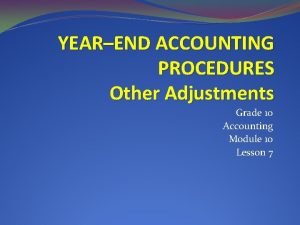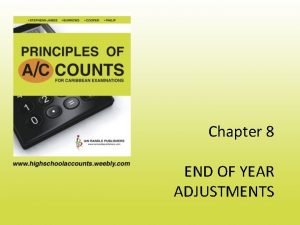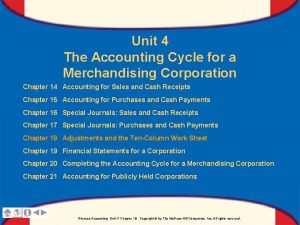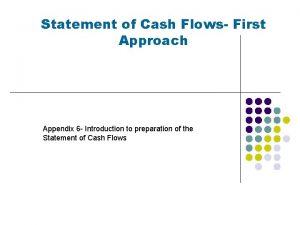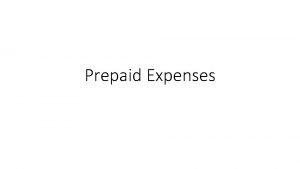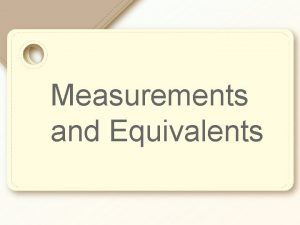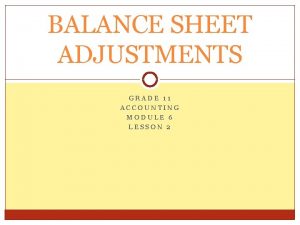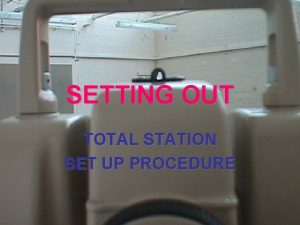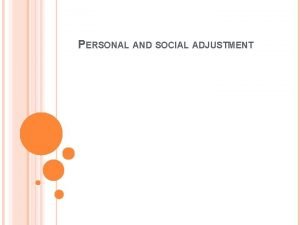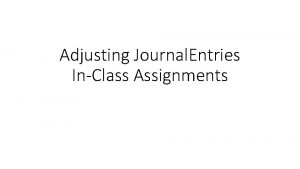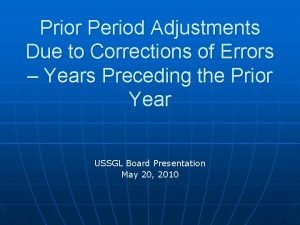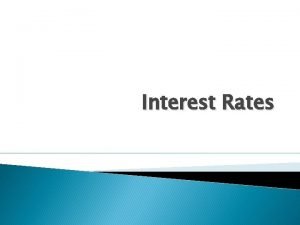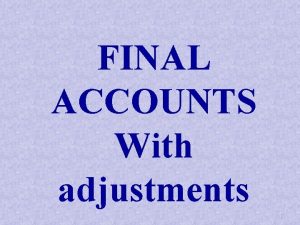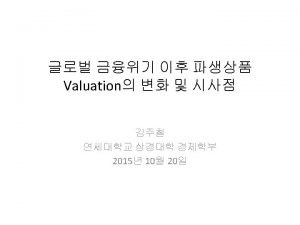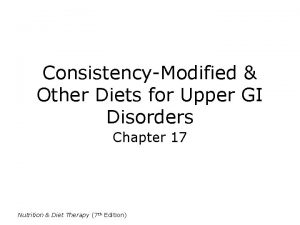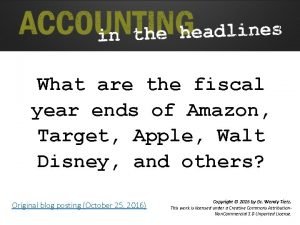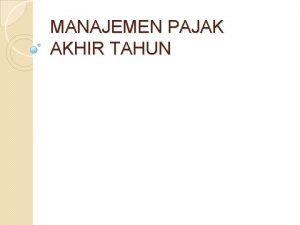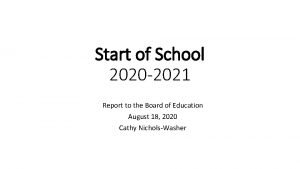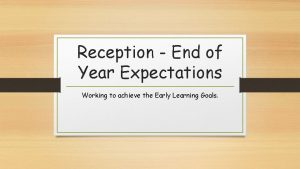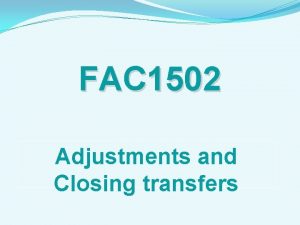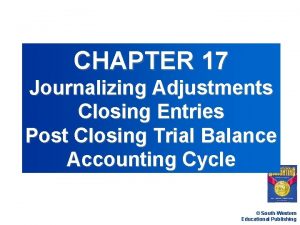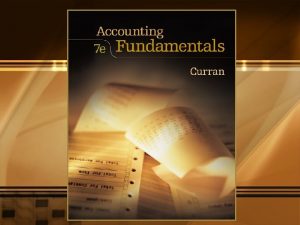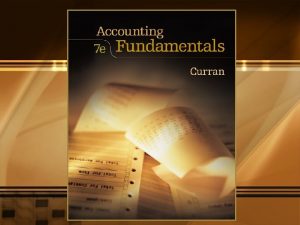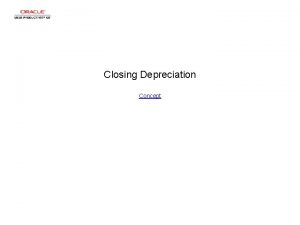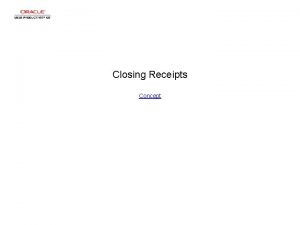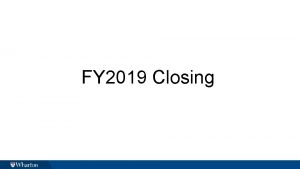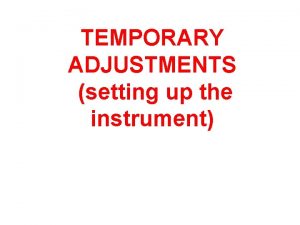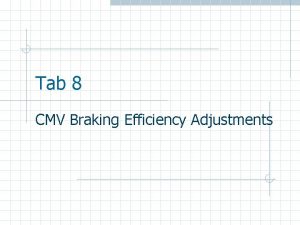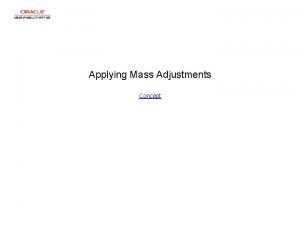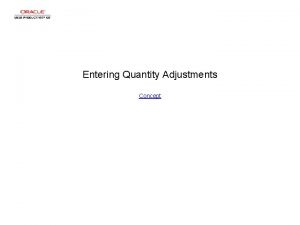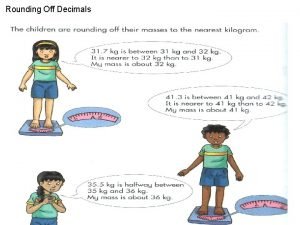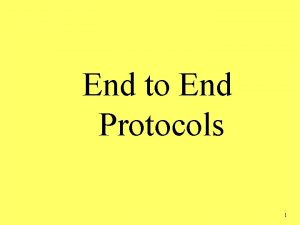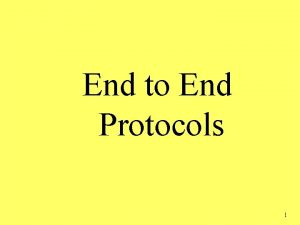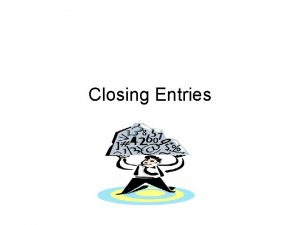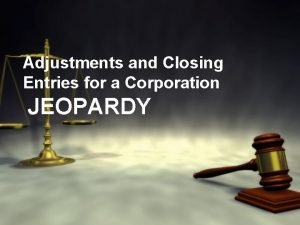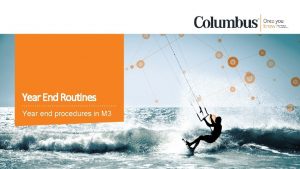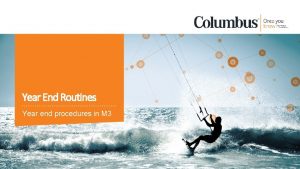Chapter 8 END OF YEAR ADJUSTMENTS Closing off





























- Slides: 29

Chapter 8 END OF YEAR ADJUSTMENTS

Closing off Account The balances of ALL expenses and income accounts are closed off to the Income Statement (Trading and Profit and Loss Account) at the end of the accounting period.

Closing off Accounts Purchases A/c 2000 4 216 02 -July Delis 375 31 July Income Statement 02 -July Cash 870 02 -July Bank 725 02 -July F. Bolth 706 18 -July Cash 430 18 -July F. Bolth 1 110 4 216

Closing off Account Journal Entry Date Details 2000 July 31 Income Statement Purchases A/c To transfer the purchases account at the end of the period folio Dr. $ Cr $ 4 216

Closing off Accounts Sales A/c 31 July Income Statement 04 -July C. Bailey 1 430 04 -July B. Hughes 1 620 04 -July H. Spencer 1 760 21 -July B. Hughes 670 5 480 2000 5 480

Closing off Account Journal Entry Date Details 2000 July 31 Sales A/c Income Statement To transfer the sales account at the end of the period folio Dr. $ Cr $ 5 480

Adjustments • Adjustments are any transactions or events which were not recorded at the time of preparation of the Trial Balance; • Apart from omitted transactions, many other adjustments occur as a result of applying the matching/accrual and realisation concepts; • Adjustments must be done before preparing the Final accounts (Manufacturing, Income Statement and Balance Sheet) are prepared; • Adjustments appear as notes after the Trial Balance totals.

Adjustment: Income The Realisation concept states that amount for income to be used to prepare the Income Statement is the amount which should be collected from the sale goods or the provision of services during the accounting period under review even if cash has not been collected.

Adjustment: Income Cash collected during the accounting period X Add owing at close Collected in advance at start x x Less Owing at start (x) Collected in advance at close (x) Income for the period Income owing = current asset X Income collected in advance = current liability

Adjustment: Income dr Income Account cr Income owing at start x Income in advance at start x Income Statement (Income for period) x Cash (received) x Income in advance at close x Income owing at close x x x Income owing = current asset Income in advance = current liability NB. Assets and liabilities are also used in the Balance Sheet

Adjustment: Expense The matching/accrual concept states that all the expenses incurred (supposed to be paid) in an accounting period to produce income should be recorded in the trading and profit and loss account even if not paid.

Adjustment: Expense i. The accounting period for which the Income Statement A/c is to be prepared must be identified. Pay attention to the date, the month and the year; ii. If any amount is relevant to the accounting period then add to cash paid during the same accounting period; iii. If any amount is not relevant to the accounting period then subtract from cash paid during the same accounting period. ; iv. A prepayment takes place if the amount of an expense paid during the accounting period is greater than the amount to be paid; v. An accrual takes place when the amount of an expense actually paid during the accounting period is less than the amount to be paid.

Adjustment: Expense Cash paid during the accounting period X Add owing at close x Paid in advance at start x Less Owing at start (x) Paid in advance at close (x) Expense for the period Prepaid expense = current asset X Expense owing = current liability

Adjustment: Expense dr Expense Account cr Prepaid expense at start x Expense owing at start x Cash paid x Income Statement x Expense owing at close x Prepaid expense at close x x x Prepaid expense = current asset Expense owing = current liability NB. Assets and liabilities are also used in the Balance Sheet

Adjustment: Depreciation • Fixed or non current assets are resources which allow a controlling firm to gain economic benefits over a period of more than one year in the future; • Depreciation is the portion of the cost of a fixed asset expended or used up during each accounting period for which the fixed asset is used or held;

Adjustment: Depreciation • Land used for development and not for mining is the only fixed asset that is not depreciated. • Depreciation is therefore a non-cash expense. • The reasons for depreciation are: use; wear and tear; obsolescence (new model making the old model out of date); and time.

Adjustment: Depreciation Estimating annual depreciation charge or expense The straight line method either Cost of the fixed asset less estimated scrap/residual value Estimated useful life of the fixed asset Or Cost of the fixed asset x annual rate of the depreciation

Adjustment: Depreciation Estimating annual depreciation charge or expense Reducing balance method Net book value of the fixed asset x annual rate of the depreciation Cost of fixed asset less total previous depreciation expense (aggregate/accumulated/provision for depreciation)

Adjustment: Depreciation Methods compared

Adjustment: Depreciation Methods compared • In the earlier years the annual expense under the reducing balance is greater than the straight-line method; • While in later years the annual expense under the reducing balance is less than the straight-line method. • Using the straight-line method gives a fixed annual depreciation expense. It is only if the cost of fixed assets changes that the annual expense will change.

Adjustment: Depreciation Double Entry Date Details Depreciation expense Provision for or accumulated depreciation folio Dr. $ Cr $ x x To record the depreciation charge or expense for the period The balance of the provision for depreciation account is used in the Balance Sheet as a contra asset. The account records the sum of annual depreciation charge from the date of purchase of the fixed asset. The balance of the depreciation expense account is used in the Income Statement as an expense

Adjustment: Depreciation Balance sheet extract Fixed Assets e. g Cost Provision for Depreciation Net Book Value Year 1 Motor Car 450, 000. 00 (72, 000. 00) 378, 000 Year 2 Motor Car 450, 000. 00 (144, 000. 00) 306, 000 Year 3 Motor Car 450, 000. 00 (216, 000. 00) 234, 000 Year 4 Motor Car 450, 000. 00 (288, 000. 00) 162, 000

Adjustment: Bad Debts A bad debt occurs anytime a business is unable to collect any amount from a debtor (someone to whom goods were sold on credit). A debtor may not be able to pay because of death, bankruptcy or if (s)he has flees the country.

Adjustment: Bad Debts When a debt becomes uncollectable it is written off as follows: Date Details Bad debts Debtors (Name) folio Dr. $ Cr $ x x To record bad debt written off The written off customer balance is transferred to the Bad debt A/c. This reduced the value of debtors. The bad debt a/c balance is a loss or an expense and is used the Income Statement. Note the above double entry must be carried out only if a note detailing bad debts appears after the Trial Balance totals. If bad debts only appear in the Trial Balance, it must only be used in the Income Statement.

Adjustment: Provision for Bad Debts • A provision for bad debts or doubtful debts represents an estimation of the value of debtors who may not pay or may default. This is another example of a non cash expense; • The aim of an initial provision for bad or doubtful is to set aside an amount from profits to cover the value of debtors who may default; • The value of debtors who may be default is normally expressed as a percent

Adjustment: Provision for Bad Debts The example below shows the debtors balances of a firm for three consecutive years. A provision for bad debts is to be establish at 5%. 2001 2002 2003 Debtors 25, 000 35, 000 24, 000 Value of ending provision @ 5% of debtors after bad debts 1 250 1 750 1 200

Adjustment: Provision for Bad Debts The value of the ending provision for bad debts is entered in the Balance Sheet for each year as a contra asset and subtracted from debtors Balance Sheet extract 2001 2002 2003 Debtors 25, 000 35, 000 24, 000 Provision for bad debts (1 250) (1 750) (1 200) Net debtors 23 750 33 250 22 800

Adjustment: Provision for Bad Debts Only the increase or decrease in the provision for bad debt balance is entered in the Income Statement: An increase as an expense i. e. $1 250 and $ 500 for the accounting period 2002 and 2001 respectively A decrease as income i. e. $550 for 2003 Increase (decrease) 2001 2002 2003 (1 250 -0) = 1 250 (1 750 – 1 250) (1 200 – 1 750) = 500 = (550) The opening balance of a provision for bad debts will be found in the Trial Balance, while the closing balance will be given in a note after the Trial Balance totals

Adjustment: Provision for Bad Debts Provision for bad debt a/c 2001 31 -Dec Bal c/d 1 250 31 -Dec Income Statement 1 250 1 -Jan Bal b/d 1 250 31 -Dec Income Statement 500 2002 31 -Dec Bal c/d 1 750 2003 31 -Dec Income Statement 550 31 -Dec Bal c/d 1 200 1 -Jan Bal b/d 1 750 2004 1 -Jan Bal b/d 1 200
 Adjustments in accounting grade 10
Adjustments in accounting grade 10 Accounting adjustments grade 10
Accounting adjustments grade 10 Closing off the year
Closing off the year Primary school leavers poem
Primary school leavers poem Journalizing adjusting entries
Journalizing adjusting entries Elbows off the table fingers off the food song
Elbows off the table fingers off the food song Cash first approach
Cash first approach Balance day adjustments general journal
Balance day adjustments general journal Measurements equivalents and adjustments
Measurements equivalents and adjustments Balance sheet grade 11
Balance sheet grade 11 Setting up a total station
Setting up a total station Personal and social adjustment ppt
Personal and social adjustment ppt Qs 3-10 unearned (deferred) revenues adjustments lo p2
Qs 3-10 unearned (deferred) revenues adjustments lo p2 Prior period adjustments are reported in the
Prior period adjustments are reported in the Quotes
Quotes Adjustments in final accounts
Adjustments in final accounts Two types of adjustments to list or quoted price are
Two types of adjustments to list or quoted price are Credit value adjustments
Credit value adjustments Iron butterfly options adjustments
Iron butterfly options adjustments Dietary adjustments after a gastrectomy are influenced by
Dietary adjustments after a gastrectomy are influenced by When does amazon's fiscal year end
When does amazon's fiscal year end Greenville bar cle
Greenville bar cle End of year review objectives
End of year review objectives End of the year poetry
End of the year poetry Perencanaan pajak menjelang akhir tahun
Perencanaan pajak menjelang akhir tahun End of year school reports 2021
End of year school reports 2021 Reception end of year expectations
Reception end of year expectations Stroke volume units
Stroke volume units Ejection fraction vs stroke volume
Ejection fraction vs stroke volume Front end of a compiler
Front end of a compiler
